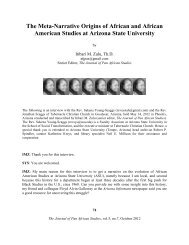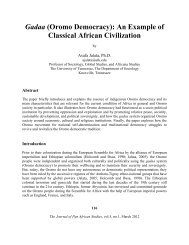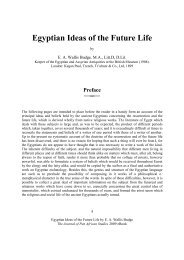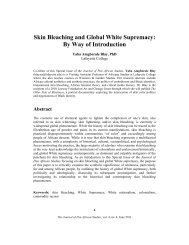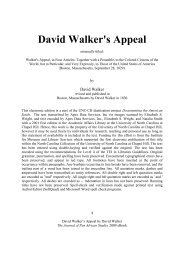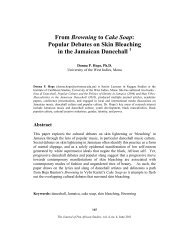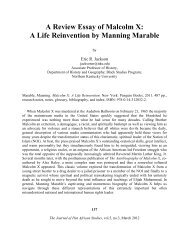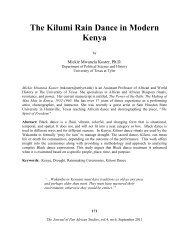Jacob H. Carruthers and the African - Journal of Pan African Studies
Jacob H. Carruthers and the African - Journal of Pan African Studies
Jacob H. Carruthers and the African - Journal of Pan African Studies
You also want an ePaper? Increase the reach of your titles
YUMPU automatically turns print PDFs into web optimized ePapers that Google loves.
Moral Instruction in Ancient Kemet<br />
Moral instruction was <strong>the</strong> perhaps <strong>the</strong> most intimate <strong>and</strong> pervasive aspect <strong>of</strong> Kemetic<br />
education, as it was centered within <strong>the</strong> family <strong>and</strong> also embedded in various aspects <strong>of</strong> <strong>the</strong><br />
social structure including literary productions, scribal education, <strong>and</strong> philosophies <strong>of</strong> governance<br />
(<strong>Carru<strong>the</strong>rs</strong> 1984, 1995, 1999). <strong>Carru<strong>the</strong>rs</strong> stated, “We discover that <strong>the</strong> process <strong>of</strong> education was<br />
founded on <strong>the</strong> family model. In o<strong>the</strong>r words, instruction was conceived <strong>of</strong> as <strong>the</strong> teaching <strong>of</strong> a<br />
parent to a child, or a fa<strong>the</strong>r to his son. The foundations for <strong>the</strong> instruction was <strong>the</strong> moral<br />
guidance that <strong>the</strong> fa<strong>the</strong>r, as a responsible elder, was obligated to pass on to his children”<br />
(<strong>Carru<strong>the</strong>rs</strong> 1999, 258). Thus in <strong>the</strong> Kemetic model, <strong>the</strong> family was an educational unit. It had<br />
achieved <strong>the</strong> pivotal role <strong>of</strong> cultural unit in its efforts to reproduce <strong>the</strong> ideals <strong>of</strong> <strong>African</strong> culture<br />
(Du Bois 1973, 152-153). Additionally, this “family model” expressed <strong>the</strong> relationship between<br />
national elders <strong>and</strong> subsequent generations <strong>of</strong> youth in Kemetic society. Ptah Hotep’s instructions<br />
are indicative <strong>of</strong> this. Here an elder statesman <strong>of</strong>fers a moral instruction to <strong>the</strong> national family<br />
(<strong>Carru<strong>the</strong>rs</strong> 1995, 119-122).<br />
The importance <strong>of</strong> moral instruction cannot be understated as it was seen as being vital to<br />
<strong>the</strong> preservation <strong>of</strong> <strong>the</strong> society’s core values. <strong>Carru<strong>the</strong>rs</strong> stated that “Teaching by elders <strong>and</strong><br />
learning by children is <strong>the</strong> only method for preserving <strong>the</strong> culture <strong>and</strong> for passing on <strong>the</strong><br />
wisdom” (<strong>Carru<strong>the</strong>rs</strong> 1983, 102-103). Thus in <strong>the</strong> Kemetic model, <strong>the</strong> family was upheld as <strong>the</strong><br />
core unit <strong>of</strong> socialization. It was <strong>the</strong> institution that did not simply ensure <strong>the</strong> reproduction <strong>of</strong><br />
society’s inhabitants, but also <strong>the</strong> reproduction <strong>and</strong> intergenerational transmission <strong>of</strong> <strong>the</strong> culture<br />
which sustained <strong>the</strong>m. This process mitigated <strong>the</strong> occurrence <strong>of</strong> a corrosive <strong>and</strong> alienating<br />
intergenerational discontinuity as “…education is an intergenerational conversation” (<strong>Carru<strong>the</strong>rs</strong><br />
1995, 115). It ensured that <strong>the</strong> cultural values <strong>of</strong> <strong>the</strong> society were transmitted from <strong>the</strong> ancestors<br />
via <strong>the</strong> elders to <strong>the</strong> youth, who were <strong>the</strong> future.<br />
One <strong>of</strong> <strong>the</strong> most notable <strong>of</strong> <strong>Carru<strong>the</strong>rs</strong>’ contributions to <strong>the</strong> study <strong>of</strong> Kemetic education is<br />
his discourse on Mdw Nfr or Good Speech as an essential expression <strong>of</strong> wisdom in Kemetic<br />
society (second only to Divine Speech or Mdw Ntr). <strong>Carru<strong>the</strong>rs</strong> states that Kemetic culture<br />
viewed <strong>the</strong> process <strong>of</strong> human consciousness <strong>and</strong> engagement as being inextricably linked to <strong>the</strong><br />
process <strong>of</strong> speech.<br />
The wisdom <strong>of</strong> Shabaka begins with <strong>the</strong> recognition that experience defined as sensory<br />
perception is an initiator <strong>of</strong> <strong>the</strong> process <strong>of</strong> knowing. This epistemological principle which Francis<br />
Bacon <strong>and</strong> his followers (i.e., <strong>the</strong> modern scientists) elevated to <strong>the</strong> position <strong>of</strong> <strong>the</strong> one <strong>and</strong><br />
only source <strong>of</strong> knowledge was only part <strong>of</strong> <strong>the</strong> Kemetic epistemology. For <strong>the</strong> Kemites, speech is<br />
really <strong>the</strong> operational base <strong>of</strong> knowledge, i.e., it is through speech that we know. Let me<br />
reconstruct <strong>the</strong> explanation: <strong>the</strong> senses bring impressions to <strong>the</strong> mind which forms perceptions;<br />
<strong>the</strong>n <strong>the</strong> tongue repeats what <strong>the</strong> mind thinks. Whatever <strong>the</strong> thinking process is, in its own<br />
right, when one learns to speak, speech takes over <strong>the</strong> process. In o<strong>the</strong>r words, one thinks in<br />
speech. . . . Thus one may say <strong>the</strong> “word” truly creates for human consciousness. (<strong>Carru<strong>the</strong>rs</strong><br />
1995, 43-44)<br />
35<br />
The <strong>Journal</strong> <strong>of</strong> <strong>Pan</strong> <strong>African</strong> <strong>Studies</strong>, vol.5, no.4, June 2012



